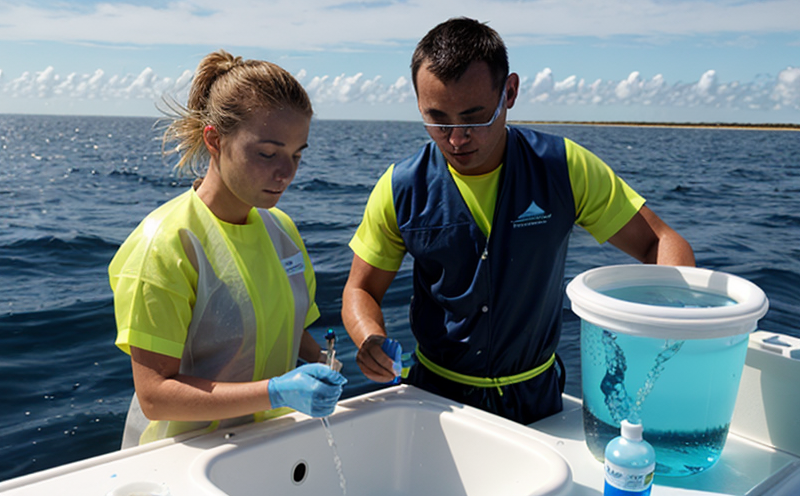ISO 7899-2 Enterococci Test in Seawater
The ISO 7899-2 standard provides a method to determine the presence and concentration of Enterococcus spp. in seawater. This test is critical for monitoring water quality, particularly in coastal areas where contamination from sewage or agricultural runoff can pose significant health risks. Compliance with this standard ensures that drinking water supplies derived from seawater meet stringent microbiological safety criteria as defined by international standards.
The procedure involves several key steps: sampling of the seawater at specified locations, preservation and transport to a certified laboratory, pre-enrichment using specific growth media, selective plating on chromogenic agar, incubation conditions, and final identification through colony morphology and biochemical tests. This method is designed to detect even low levels of Enterococcus, which are indicators of fecal pollution.
The significance of this test extends beyond just compliance with regulatory requirements; it also plays a crucial role in safeguarding public health by identifying potential sources of contamination early on. Regular testing helps water utilities and environmental agencies to implement corrective measures promptly, thereby reducing the risk of widespread infections among populations dependent on seawater for drinking or recreational purposes.
The ISO 7899-2 standard is widely accepted globally due to its stringent protocols that ensure accurate detection rates. However, successful implementation requires expertise not just in microbiology but also in environmental monitoring practices. Laboratories specializing in this service must adhere strictly to the outlined procedures and maintain proficiency through continuous training and validation exercises.
For quality managers responsible for ensuring product safety or compliance officers tasked with upholding regulatory standards, understanding this testing procedure is paramount. By leveraging the expertise of certified laboratories equipped with advanced facilities, these professionals can make informed decisions that protect both human health and aquatic ecosystems.
In summary, the ISO 7899-2 Enterococci Test in Seawater serves as a vital tool for maintaining water quality standards. Its importance lies in its ability to pinpoint specific microbial indicators indicative of pollution sources, enabling timely interventions before they escalate into public health crises.
Scope and Methodology
The ISO 7899-2 standard outlines a precise methodology for detecting Enterococcus spp. in seawater. The process begins with sampling, which should be conducted at designated points along the coastline or near relevant industrial facilities to capture representative samples of the water body being monitored.
- Sampling: Samples are collected using sterile containers and preserved according to specified guidelines to prevent contamination during transit.
- Pre-enrichment: After arrival at the laboratory, samples undergo pre-enrichment in a nutrient broth suitable for Enterococcus. This step increases the concentration of target organisms, making them more detectable on subsequent steps.
- Selective Plating: Post-pre-enrichment, selective plating onto chromogenic agar is performed. These agars contain dyes that change color in the presence of Enterococcus, facilitating rapid identification.
- Incubation: Plates are incubated under controlled conditions suitable for optimal growth and differentiation of colonies.
- Identification: Finally, colonies displaying characteristic morphological features typical of Enterococcus are identified through further biochemical tests if necessary.
The entire process is meticulously documented throughout to ensure traceability and repeatability. Compliance with ISO 7899-2 guarantees accurate results that can be relied upon for regulatory submissions or internal quality control purposes.
Industry Applications
- Water Treatment Plants: Essential for monitoring incoming seawater before treatment processes begin, ensuring no contamination enters the purification system.
- Environmental Monitoring: Used extensively by governmental and non-governmental organizations to assess water quality in coastal regions.
- Retailer Supply Chains: Helps ensure that bottled or packaged drinking water products derived from seawater are safe for consumer use.
This testing service finds application across various sectors including but not limited to environmental protection agencies, private water companies, and research institutions conducting studies on marine microbiology. Its role in maintaining public health makes it indispensable for any entity involved directly or indirectly with seawater management.
Use Cases and Application Examples
| Scenario | Description |
|---|---|
| Sewage Overflow Incident | Detecting elevated Enterococcus levels immediately after a sewage overflow alerts authorities to the extent of contamination and helps in formulating containment strategies. |
| New Water Source Evaluation | Before opening up new seawater intake points, comprehensive testing ensures that they do not introduce unacceptable microbial loads into existing distribution networks. |
| Seasonal Monitoring Programs | Regular checks help track changes in water quality over time, identifying trends indicative of long-term environmental shifts or short-lived events like heavy rainfall. |
These scenarios underscore the versatility and importance of ISO 7899-2 testing across different temporal scales—from immediate response to ongoing surveillance. Each case highlights how precise detection of Enterococcus spp. contributes significantly towards achieving sustainable water management goals.





